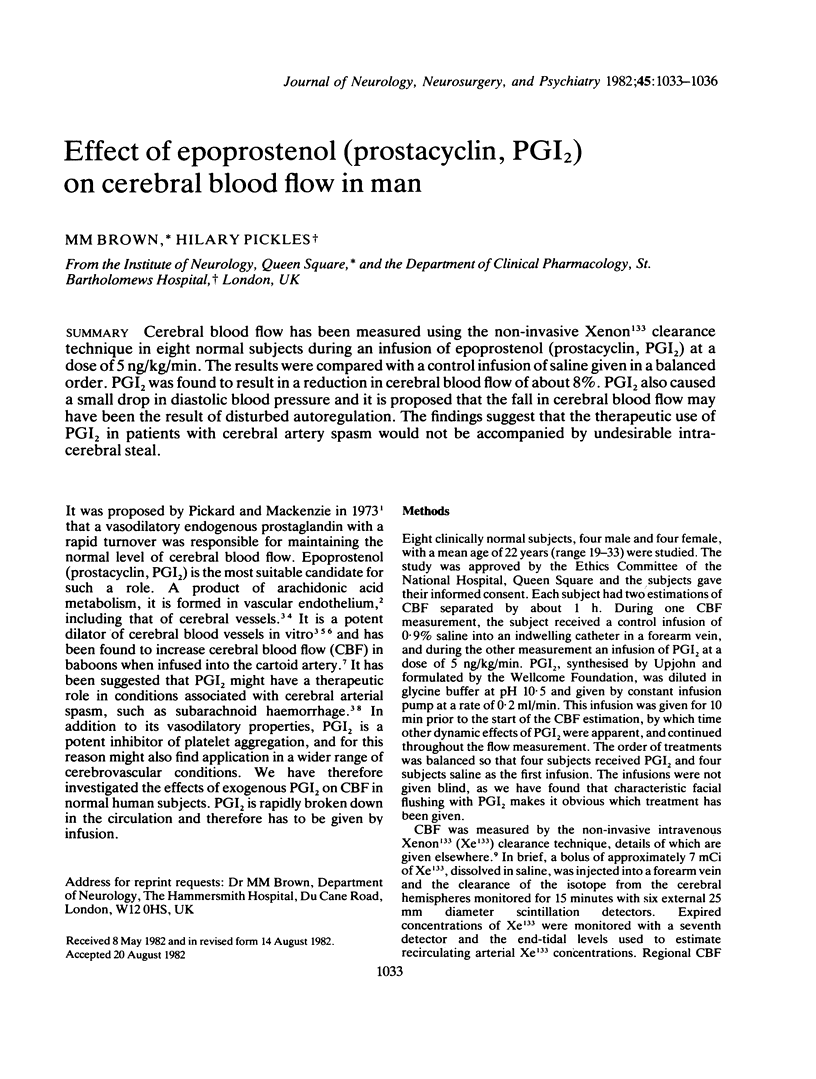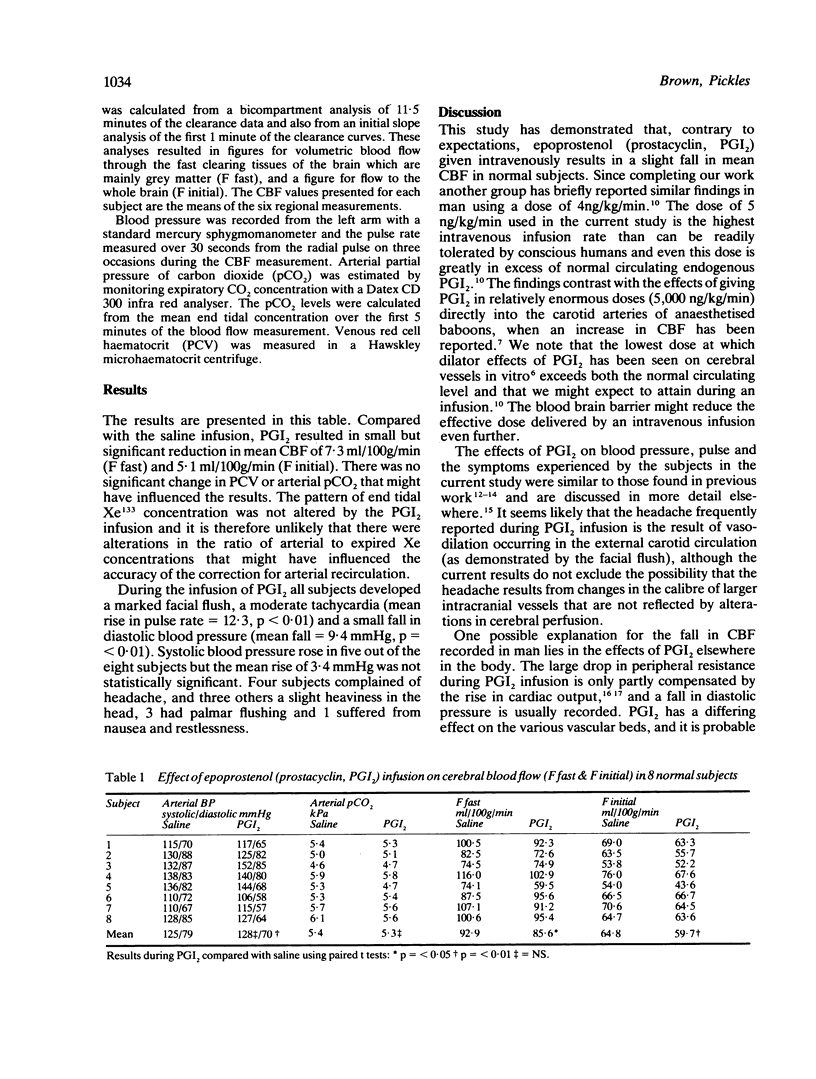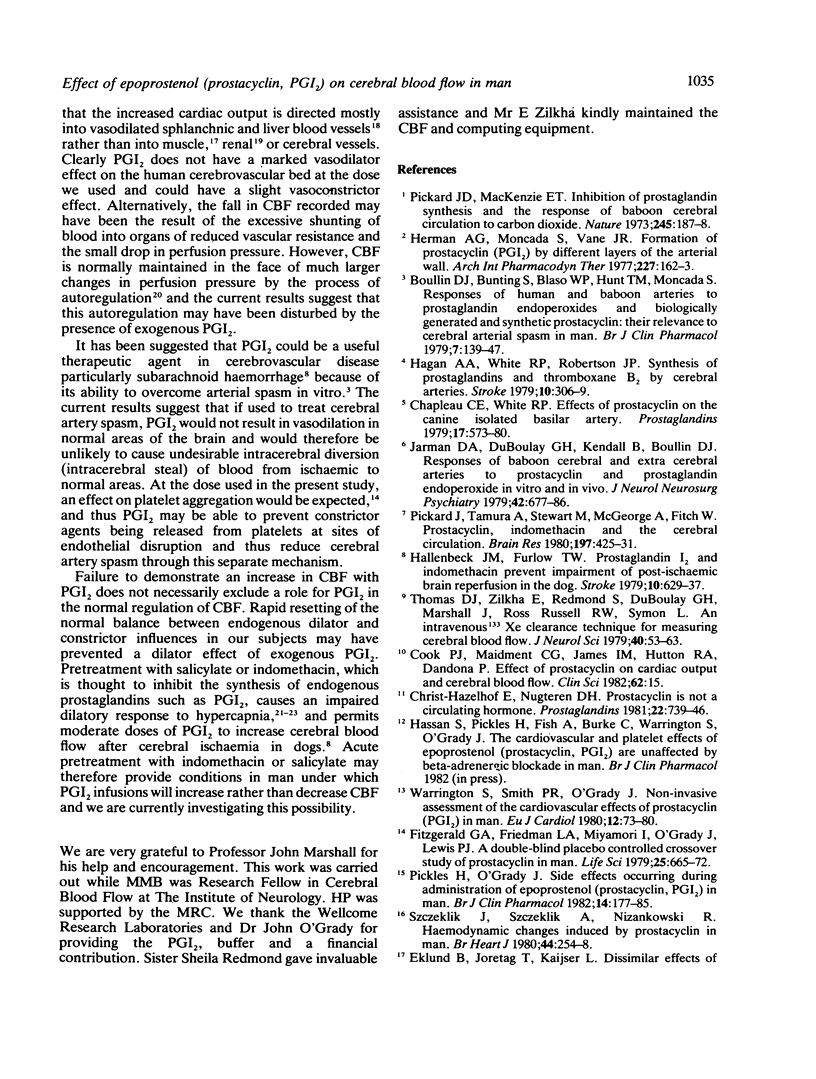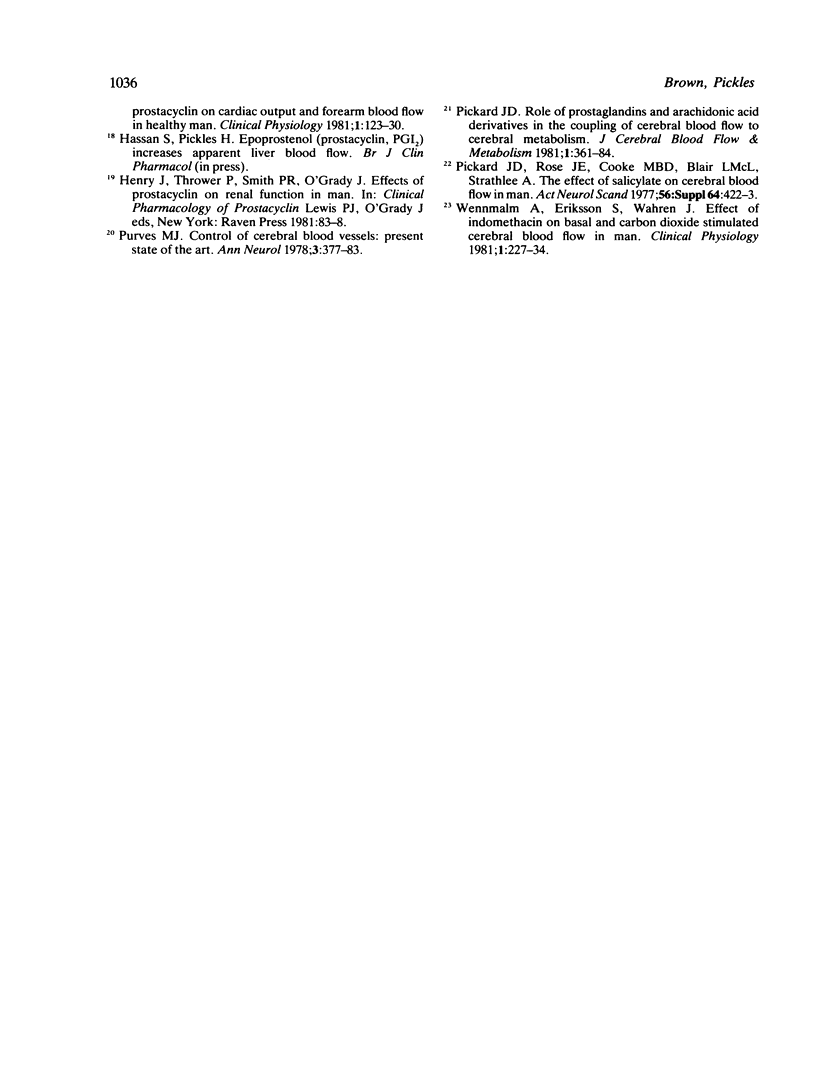Abstract
Cerebral blood flow has been measured using the non-invasive Xenon133 clearance technique in eight normal subjects during an infusion of epoprostenol (prostacyclin, PGI2) at a dose of 5 ng/kg/min. The results were compared with a control infusion of saline given in a balanced order. PGI2 was found to result in a reduction in cerebral blood flow of about 8%. PGI2 also caused a small drop in diastolic blood pressure and it is proposed that the fall in cerebral blood flow may have been the result of disturbed autoregulation. The findings suggest that the therapeutic use of PGI2 in patients with cerebral artery spasm would not be accompanied by undesirable intracerebral steal.
Full text
PDF



Selected References
These references are in PubMed. This may not be the complete list of references from this article.
- Boullin D. J., Bunting S., Blaso W. P., Hunt T. M., Moncada S. Responses of human and baboon arteries to prostaglandin endoperoxides and biologically generated and synthetic prostacyclin: their relevance to cerebral arterial spasm in man. Br J Clin Pharmacol. 1979 Feb;7(2):139–147. doi: 10.1111/j.1365-2125.1979.tb00914.x. [DOI] [PMC free article] [PubMed] [Google Scholar]
- Chapleau C. E., White R. P. Effects of prostacyclin on the canine isolated basilar artery. Prostaglandins. 1979 Apr;17(4):573–580. doi: 10.1016/0090-6980(79)90008-x. [DOI] [PubMed] [Google Scholar]
- Christ-Hazelhof E., Nugteren D. H. Prostacyclin is not a circulating hormone. Prostaglandins. 1981 Nov;22(5):739–746. doi: 10.1016/0090-6980(81)90213-6. [DOI] [PubMed] [Google Scholar]
- FitzGerald G. A., Friedman L. A., Miyamori I., O'Grady J., Lewis P. J. A double blind placebo controlled crossover study of prostacyclin in man. Life Sci. 1979 Aug 20;25(8):665–672. doi: 10.1016/0024-3205(79)90507-1. [DOI] [PubMed] [Google Scholar]
- Hagen A. A., White R. P., Robertson J. T. Synthesis of prostaglandins and thromboxane B2 by cerebral arteries. Stroke. 1979 May-Jun;10(3):306–309. doi: 10.1161/01.str.10.3.306. [DOI] [PubMed] [Google Scholar]
- Hallenbeck J. M., Furlow T. W., Jr Prostaglandin I2 and indomethacin prevent impairment of post-ischemic brain reperfusion in the dog. Stroke. 1979 Nov-Dec;10(6):629–637. doi: 10.1161/01.str.10.6.629. [DOI] [PubMed] [Google Scholar]
- Herman A. G., Moncada S., Vane J. R. Formation of prostacyclin (PGl2) by different layers of the arterial wall. Arch Int Pharmacodyn Ther. 1977 May;227(1):162–163. [PubMed] [Google Scholar]
- Jarman D. A., Du Boulay G. H., Kendall B., Boullin D. J. Responses of baboon cerebral and extracerebral arteries to prostacyclin and prostaglandin endoperoxide in vitro and in vivo. J Neurol Neurosurg Psychiatry. 1979 Aug;42(8):677–686. doi: 10.1136/jnnp.42.8.677. [DOI] [PMC free article] [PubMed] [Google Scholar]
- Pickard J. D., Mackenzie E. T. Inhibition of prostaglandin synthesis and the response of baboon cerebral circulation to carbon dioxide. Nat New Biol. 1973 Oct 10;245(145):187–188. doi: 10.1038/newbio245187a0. [DOI] [PubMed] [Google Scholar]
- Pickard J. D. Role of prostaglandins and arachidonic acid derivatives in the coupling of cerebral blood flow to cerebral metabolism. J Cereb Blood Flow Metab. 1981;1(4):361–384. doi: 10.1038/jcbfm.1981.41. [DOI] [PubMed] [Google Scholar]
- Pickard J., Tamura A., Stewart M., McGeorge A., Fitch W. Prostacyclin, indomethacin and the cerebral circulation. Brain Res. 1980 Sep 22;197(2):425–431. doi: 10.1016/0006-8993(80)91127-0. [DOI] [PubMed] [Google Scholar]
- Pickles H., O'Grady J. Side effects occurring during administration of epoprostenol (prostacyclin, PGI2), in man. Br J Clin Pharmacol. 1982 Aug;14(2):177–185. doi: 10.1111/j.1365-2125.1982.tb01959.x. [DOI] [PMC free article] [PubMed] [Google Scholar]
- Purves M. J. Control of cerebral blood vessels: present state of the art. Ann Neurol. 1978 May;3(5):377–383. doi: 10.1002/ana.410030502. [DOI] [PubMed] [Google Scholar]
- Szczeklik J., Szczeklik A., Nizankowski R. Haemodynamic changes induced by prostacyclin in man. Br Heart J. 1980 Sep;44(3):254–258. doi: 10.1136/hrt.44.3.254. [DOI] [PMC free article] [PubMed] [Google Scholar]
- Thomas D. J., Zilkha E., Redmond S., Du Boulay G. H., Marshall J., Russell R. W., Symon L. An intravenous 133xenon clearance technique for measuring cerebral blood flow. J Neurol Sci. 1979 Jan;40(1):53–63. doi: 10.1016/0022-510x(79)90008-x. [DOI] [PubMed] [Google Scholar]
- Warrington S. J., Smith P. R., O'Grady J. Noninvasive assessment of the cardiovascular effects of prostacyclin (PGI2) in man. Eur J Cardiol. 1980;12(2):73–80. [PubMed] [Google Scholar]


